

Compact Muon Solenoid
LHC, CERN
| CMS-PAS-HIN-22-004 | ||
| Dependence of two-particle azimuthal correlations on the forward rapidity gap width in pPb collisions at $ \sqrt {\smash [b]{s_{_{\mathrm {NN}}}}}= $ 8.16 TeV | ||
| CMS Collaboration | ||
| 3 June 2024 | ||
| Abstract: Measurements of the Fourier coefficients ($ V_{n\Delta} $) of the azimuthal distributions of charged hadron pairs produced in pPb collisions at 8.16 TeV are presented as functions of the forward rapidity gap width ($ \Delta\eta^{\rm{F}} $) for events in which particle production is concentrated in the direction of the outgoing Pb beam. The sample includes contributions from pomeron and photon induced processes as well as nondiffractive events. The data correspond to a luminosity of 174.5 nb$^{-1}$ recorded with the CMS detector in the LHC Run 2. The mean track multiplicity decreases by 53% from the bin 0 $ \leq\Delta\eta^{\rm{F}} < $ 0.5 to that with $ \Delta\eta^{\rm{F}} > $ 2.5. The dependence of the results on the track multiplicity and the transverse momentum of the charged particles is also studied for the most forward events ($ \Delta\eta^{\rm{F}} > $ 2.5). The measured values of $ V_{1\Delta} $ are negative and decrease with $ \Delta\eta^{\rm{F}} $, while those of $ V_{2\Delta} $ are positive for the $ \Delta\eta^{\rm{F}} $ bins $ [0.5,1) $, $ [1,1.5) $, $ [2,2.5) $, and are consistent with zero elsewhere. The measured values of the elliptic flow coefficient ($ v_2 $) is provided for the $ \Delta\eta^{\rm{F}} $ bins $ [0.5,1) $, $ [1,1.5) $, $ [2,2.5) $. In the other bins, the $ v_2 $ results are consistent with zero. In these bins, upper limits at 95% C.L. are determined, ranging up to 0.13 for the most inclusive category. The values of the upper limits are similar to the values of $ v_2 $ measured in $ \gamma $p collisions with comparable multiplicity. | ||
| Links: CDS record (PDF) ; CADI line (restricted) ; | ||
| Figures | |

png pdf |
Figure 1:
Sketch of a single-diffractive pPb event (left). The interaction proceeds via the exchange of a pomeron ($\text{ IP} $); the proton remains intact or dissociates into a low-mass state, and the nucleus breaks up (X). A single-diffractive event as seen in the detector (right). Activity is observed only in one side of the detector and a large forward rapidity gap ($ {\Delta\eta^{\rm{F}} } $) is present. Both diagrams are extracted from [47]. |

png pdf |
Figure 1-a:
Sketch of a single-diffractive pPb event (left). The interaction proceeds via the exchange of a pomeron ($\text{ IP} $); the proton remains intact or dissociates into a low-mass state, and the nucleus breaks up (X). A single-diffractive event as seen in the detector (right). Activity is observed only in one side of the detector and a large forward rapidity gap ($ {\Delta\eta^{\rm{F}} } $) is present. Both diagrams are extracted from [47]. |
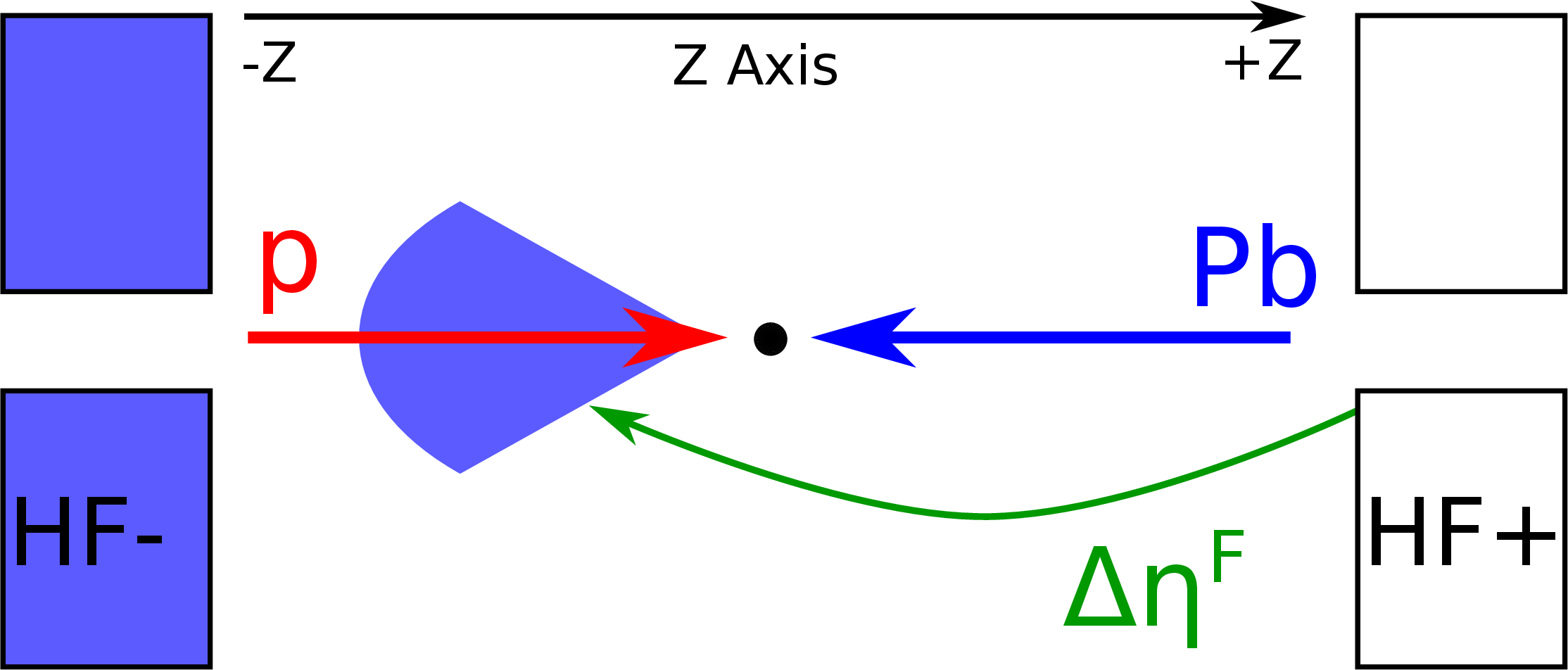
png pdf |
Figure 1-b:
Sketch of a single-diffractive pPb event (left). The interaction proceeds via the exchange of a pomeron ($\text{ IP} $); the proton remains intact or dissociates into a low-mass state, and the nucleus breaks up (X). A single-diffractive event as seen in the detector (right). Activity is observed only in one side of the detector and a large forward rapidity gap ($ {\Delta\eta^{\rm{F}} } $) is present. Both diagrams are extracted from [47]. |
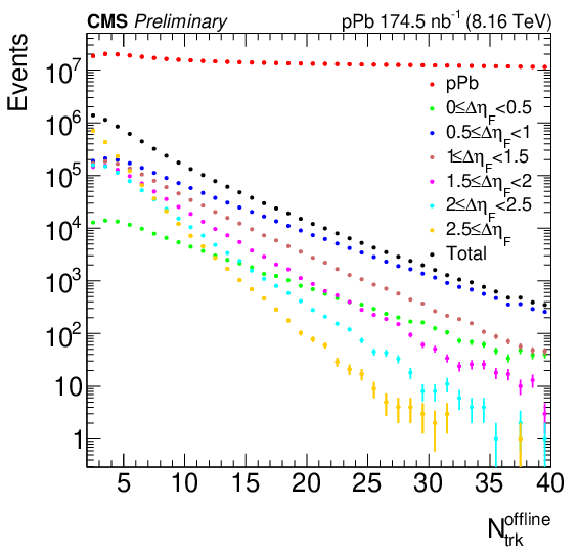
png pdf |
Figure 2:
$ N_{\mathrm{trk}}^{\mathrm{offline}} $ spectra for inclusive pPb events (labeled pPb, from Ref. [45]) and events from the nominal sample in different $ {\Delta\eta^{\rm{F}} } $ bins. |
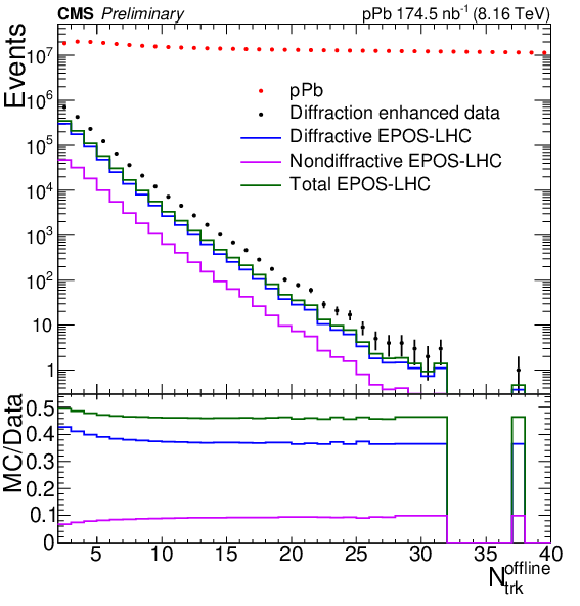
png pdf |
Figure 3:
$ N_{\mathrm{trk}}^{\mathrm{offline}} $ spectra for inclusive pPb events (labelled pPb, from Ref. [45]) and diffraction enhanced events. The distribution for the diffraction enhanced events (black data points) is the same as that shown in orange in Fig. 2 ($ {\Delta\eta^{\rm{F}} } > $ 2.5). Predictions based on EPOS-LHC are also shown. The lower panel shows the ratio of data to MC yields. |
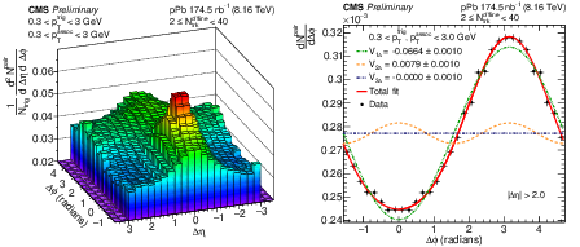
png pdf |
Figure 4:
2D correlation distribution for multiplicity (left) and its projection on the $ {\Delta\phi} $ axis for $ |{\Delta\eta}| > $ 2, 2 $ \leq N_{\mathrm{trk}}^{\mathrm{offline}} < $ 40, and 0.3 $ < \mathrm{p^{trig}_T} < $ 3 GeV (right). The one-dimensional $ {\Delta\phi} $ distributions are symmetrized by construction around $ {\Delta\phi} = $ 0 and $ {\Delta\phi} = \pi $, so all the data are contained in [0, $ \pi $] and are averaged over $ |{\Delta\eta}| > $ 2. The Fourier coefficients $ {V_{n\Delta}} $ are fitted over the $ {\Delta\phi} $ range [0, $ \pi $]. |
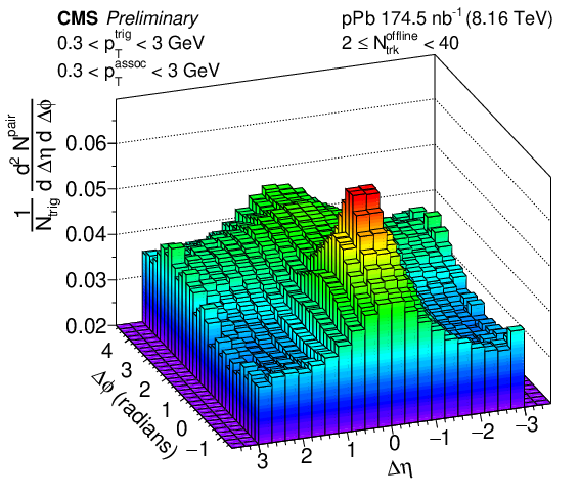
png pdf |
Figure 4-a:
2D correlation distribution for multiplicity (left) and its projection on the $ {\Delta\phi} $ axis for $ |{\Delta\eta}| > $ 2, 2 $ \leq N_{\mathrm{trk}}^{\mathrm{offline}} < $ 40, and 0.3 $ < \mathrm{p^{trig}_T} < $ 3 GeV (right). The one-dimensional $ {\Delta\phi} $ distributions are symmetrized by construction around $ {\Delta\phi} = $ 0 and $ {\Delta\phi} = \pi $, so all the data are contained in [0, $ \pi $] and are averaged over $ |{\Delta\eta}| > $ 2. The Fourier coefficients $ {V_{n\Delta}} $ are fitted over the $ {\Delta\phi} $ range [0, $ \pi $]. |
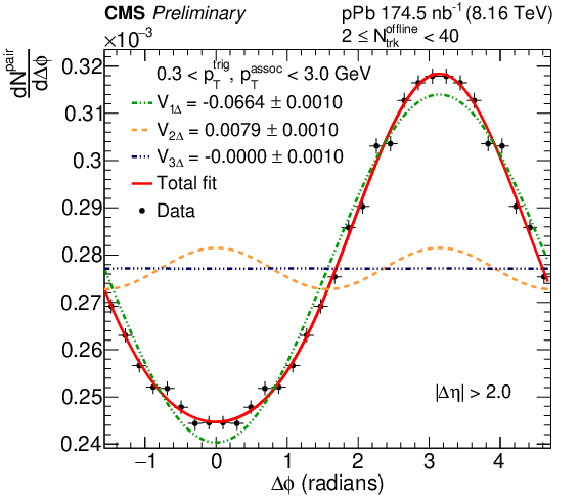
png pdf |
Figure 4-b:
2D correlation distribution for multiplicity (left) and its projection on the $ {\Delta\phi} $ axis for $ |{\Delta\eta}| > $ 2, 2 $ \leq N_{\mathrm{trk}}^{\mathrm{offline}} < $ 40, and 0.3 $ < \mathrm{p^{trig}_T} < $ 3 GeV (right). The one-dimensional $ {\Delta\phi} $ distributions are symmetrized by construction around $ {\Delta\phi} = $ 0 and $ {\Delta\phi} = \pi $, so all the data are contained in [0, $ \pi $] and are averaged over $ |{\Delta\eta}| > $ 2. The Fourier coefficients $ {V_{n\Delta}} $ are fitted over the $ {\Delta\phi} $ range [0, $ \pi $]. |
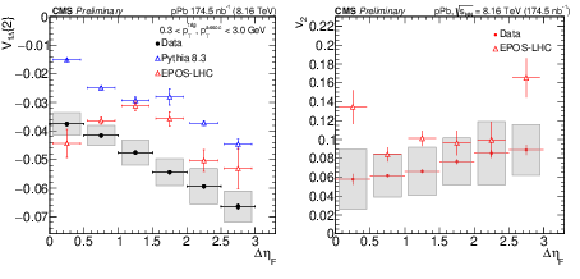
png pdf |
Figure 5:
Summary of measurements of $ V_{1\Delta} $ (left) and $ V_{2\Delta} $ (right) as a function of $ {\Delta\eta^{\rm{F}} } $. The results are for tracks with 0.3 $ < \mathrm{p^{trig}_T} < $ 3 GeV. The $ {2} $ in the $ V_{n\Delta} $ variable name means that it was measured from the correlations from particle pairs. The filled circles indicate the data. The open triangles indicate the simulation, in blue for PYTHIA 8.3 and red for EPOS-LHC. The data points are plotted at the center of the corresponding $ {\Delta\eta^{\rm{F}} } $ bin. The shaded bands indicate the size of the systematic uncertainties. The vertical lines indicate the size of the statistical uncertainties. |

png pdf |
Figure 5-a:
Summary of measurements of $ V_{1\Delta} $ (left) and $ V_{2\Delta} $ (right) as a function of $ {\Delta\eta^{\rm{F}} } $. The results are for tracks with 0.3 $ < \mathrm{p^{trig}_T} < $ 3 GeV. The $ {2} $ in the $ V_{n\Delta} $ variable name means that it was measured from the correlations from particle pairs. The filled circles indicate the data. The open triangles indicate the simulation, in blue for PYTHIA 8.3 and red for EPOS-LHC. The data points are plotted at the center of the corresponding $ {\Delta\eta^{\rm{F}} } $ bin. The shaded bands indicate the size of the systematic uncertainties. The vertical lines indicate the size of the statistical uncertainties. |

png pdf |
Figure 5-b:
Summary of measurements of $ V_{1\Delta} $ (left) and $ V_{2\Delta} $ (right) as a function of $ {\Delta\eta^{\rm{F}} } $. The results are for tracks with 0.3 $ < \mathrm{p^{trig}_T} < $ 3 GeV. The $ {2} $ in the $ V_{n\Delta} $ variable name means that it was measured from the correlations from particle pairs. The filled circles indicate the data. The open triangles indicate the simulation, in blue for PYTHIA 8.3 and red for EPOS-LHC. The data points are plotted at the center of the corresponding $ {\Delta\eta^{\rm{F}} } $ bin. The shaded bands indicate the size of the systematic uncertainties. The vertical lines indicate the size of the statistical uncertainties. |
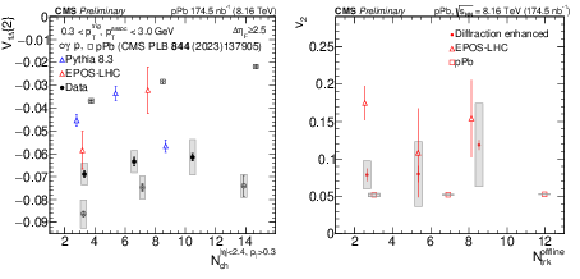
png pdf |
Figure 6:
Summary of measurements of $ V_{1\Delta} $ (left) and $ V_{2\Delta} $ (right) for the diffraction enhanced events for different classes of $ N_{\mathrm{ch}}^{|\eta | < 2.4,p_{\rm{T}} > 0.3} $. The results are for tracks with 0.3 $ < \mathrm{p^{trig}_T} < $ 3 GeV. The $ {2} $ in the $ V_{n\Delta} $ variable name means that it was measured from the correlations from particle pairs. The filled circles indicate the data. The open triangles indicate the simulation, in blue for PYTHIA 8.3 and red for EPOS-LHC. The data points are plotted at the mean of $ N_{\mathrm{ch}}^{|\eta | < 2.4,p_{\rm{T}} > 0.3} $ within the corresponding $ N_{\mathrm{trk}}^{\mathrm{offline}} $ bin. The shaded bands indicate the size of the systematic uncertainties. The vertical lines indicate the size of the statistical uncertainties. The inclusive pPb and $ \gamma $p results from Ref. [45] are also shown. |
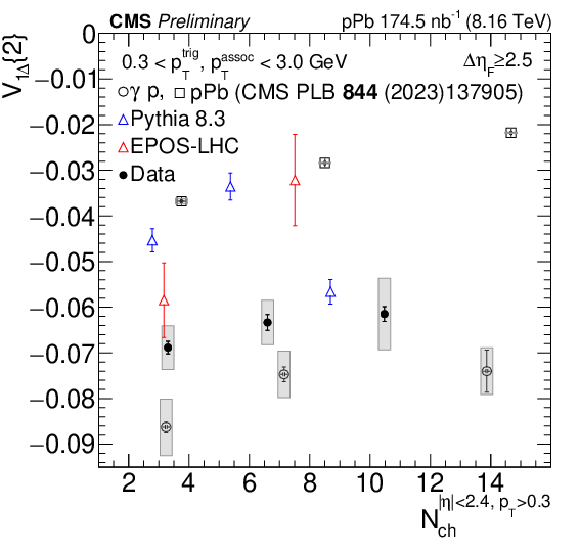
png pdf |
Figure 6-a:
Summary of measurements of $ V_{1\Delta} $ (left) and $ V_{2\Delta} $ (right) for the diffraction enhanced events for different classes of $ N_{\mathrm{ch}}^{|\eta | < 2.4,p_{\rm{T}} > 0.3} $. The results are for tracks with 0.3 $ < \mathrm{p^{trig}_T} < $ 3 GeV. The $ {2} $ in the $ V_{n\Delta} $ variable name means that it was measured from the correlations from particle pairs. The filled circles indicate the data. The open triangles indicate the simulation, in blue for PYTHIA 8.3 and red for EPOS-LHC. The data points are plotted at the mean of $ N_{\mathrm{ch}}^{|\eta | < 2.4,p_{\rm{T}} > 0.3} $ within the corresponding $ N_{\mathrm{trk}}^{\mathrm{offline}} $ bin. The shaded bands indicate the size of the systematic uncertainties. The vertical lines indicate the size of the statistical uncertainties. The inclusive pPb and $ \gamma $p results from Ref. [45] are also shown. |

png pdf |
Figure 6-b:
Summary of measurements of $ V_{1\Delta} $ (left) and $ V_{2\Delta} $ (right) for the diffraction enhanced events for different classes of $ N_{\mathrm{ch}}^{|\eta | < 2.4,p_{\rm{T}} > 0.3} $. The results are for tracks with 0.3 $ < \mathrm{p^{trig}_T} < $ 3 GeV. The $ {2} $ in the $ V_{n\Delta} $ variable name means that it was measured from the correlations from particle pairs. The filled circles indicate the data. The open triangles indicate the simulation, in blue for PYTHIA 8.3 and red for EPOS-LHC. The data points are plotted at the mean of $ N_{\mathrm{ch}}^{|\eta | < 2.4,p_{\rm{T}} > 0.3} $ within the corresponding $ N_{\mathrm{trk}}^{\mathrm{offline}} $ bin. The shaded bands indicate the size of the systematic uncertainties. The vertical lines indicate the size of the statistical uncertainties. The inclusive pPb and $ \gamma $p results from Ref. [45] are also shown. |
| Tables | |

png pdf |
Table 1:
Measured values of $ V_{n\Delta} $ as a function of $ {\Delta\eta^{\rm{F}} } $. The uncertainties include both statistical and systematic components. The table shows the $ v_2 $ results when they are non-zero. For the rest of the cases, upper limits at 95% C.L. are displayed with the $ \leq $ symbol. |

png pdf |
Table 2:
Measured values of $ V_{n\Delta} $ for the diffractive-enhanced sample as a function of $ \langle N_{\mathrm{ch}}^{|\eta | < 2.4,p_{\rm{T}} > 0.3} \rangle $ and $ N_{\mathrm{trk}}^{\mathrm{offline}} $ for both $ \mathrm{p^{trig}_T} $ bins. The uncertainties include both statistical and systematic components. The table also shows the 95% C.L. upper limits on $ v_2 $ displayed with the $ \leq $ symbol. In the lower table, $ v_2 $ values for $ \gamma $p events for 0.3 $ < \mathrm{p^{trig}_T} < $ 3 GeV [45] in similar $ N_{\mathrm{ch}}^{|\eta | < 2.4,p_{\rm{T}} > 0.3} $ ranges are given. |
| Summary |
| Long-range azimuthal two-particle correlations have been searched for in proton-lead (pPb) events at $ \sqrt{\smash[b]{s_{_{\mathrm{NN}}}}} $=8.16 TeV as a function of the forward rapidity gap width ($ {\Delta\eta^{\rm{F}} } $) and the charged particle multiplicity ($ N_{\mathrm{ch}}^{|\eta | < 2.4,p_{\rm{T}} > 0.3} $). Events have been selected by requiring an asymmetric distribution of energy in the forward and backward calorimeters, and no energy deposition in the region 2.5 $ < \eta < $ 3, so that activity is only present in the direction of the outgoing Pb beam. A separate set of measurements with a selection that enhances the fraction of diffractive events has also been carried out by requiring $ {\Delta\eta^{\rm{F}} } > $ 2.5. The average track multiplicity is lower in the diffractive sample than for inclusive proton-lead (pPb) events, but larger than for photon-proton ($ \gamma $p) events. The slope of the multiplicity distribution becomes steeper with increasing $ {\Delta\eta^{\rm{F}} } $. The mean track multiplicity $ \langle N_{\mathrm{trk}}^{\mathrm{offline}} \rangle $ decreases by 53% when $ {\Delta\eta^{\rm{F}} } $ changes from 0 $ \leq{\Delta\eta^{\rm{F}} } < $ 0.5 to $ {\Delta\eta^{\rm{F}} } > $ 2.5. The two-dimensional two-particle correlation functions have been averaged over $ |{\Delta\eta}| > $ 2 and the resulting $ {\Delta\phi} $ distributions have been studied in terms of its Fourier coefficients $ V_{1\Delta} $ and $ V_{2\Delta} $. The measured values of $ V_{1\Delta} $ are negative and decrease with $ {\Delta\eta^{\rm{F}} } $, while those of $ V_{2\Delta} $ are positive for the $ {\Delta\eta^{\rm{F}} } $ bins $ [0.5,1) $, $ [1,1.5) $, $ [2,2.5) $, and are consistent with zero elsewhere. The results have been compared with the predictions of the PYTHIA 8.3 Monte Carlo simulation, which does not include collective effects, and with EPOS-LHC simulation, which includes such effects. The measured values of the elliptic flow coefficient ($ v_2 $) are provided for the bins $ [0.5,1) $, $ [1,1.5) $, $ [2,2.5) $. In the other bins, the $ v_2 $ results are consistent with zero. In these bins, 95% confidence level upper limits have been determined; they are stable across the $ {\Delta\eta^{\rm{F}} } $ and $ N_{\mathrm{ch}}^{|\eta | < 2.4,p_{\rm{T}} > 0.3} $ regions studied, and range up to 0.13 for the most inclusive $ N_{\mathrm{trk}}^{\mathrm{offline}} $ bin. The values of the upper limits are similar to the values measured in $ \gamma $p events for comparable $ N_{\mathrm{ch}}^{|\eta | < 2.4,p_{\rm{T}} > 0.3} $ and $ \mathrm{p^{trig}_T} $ ranges. |
| References | ||||
| 1 | CMS Collaboration | Observation of long-range, near-side angular correlations in proton-proton collisions at the LHC | JHEP 09 (2010) 091 | CMS-QCD-10-002 1009.4122 |
| 2 | ATLAS Collaboration | Observation of long-range elliptic azimuthal anisotropies in $ \sqrt{s}= $13 and 2.76 TeV pp collisions with the ATLAS detector | PRL 116 (2016) 172301 | 1509.04776 |
| 3 | CMS Collaboration | Measurement of long-range near-side two-particle angular correlations in pp collisions at $ \sqrt{s} = $ 13 TeV | PRL 116 (2015) 172302 | CMS-FSQ-15-002 1510.03068 |
| 4 | CMS Collaboration | Evidence for collectivity in pp collisions at the LHC | PLB 765 (2017) 193 | CMS-HIN-16-010 1606.06198 |
| 5 | ATLAS Collaboration | Measurement of azimuthal anisotropy of muons from charm and bottom hadrons in pp collisions at $ \sqrt{s}= $ 13 TeV with the ATLAS detector | PRL 124 (2020) 082301 | 1909.01650 |
| 6 | PHENIX Collaboration | Measurement of long-range angular correlations and azimuthal anisotropies in high-multiplicity pAu collisions at $ \sqrt{\smash[b]{s_{_{\mathrm{NN}}}}} $ = 200 GeV | Phys. Rev. C 95 (2017) 034910 | 1609.02894 |
| 7 | PHENIX Collaboration | Creation of quark-gluon plasma droplets with three distinct geometries | Nature Phys. 15 (2019) 214 | 1805.02973 |
| 8 | CMS Collaboration | Observation of long-range near-side angular correlations in pPb collisions at the LHC | PLB 718 (2013) 795 | CMS-HIN-12-015 1210.5482 |
| 9 | ATLAS Collaboration | Observation of associated near-side and away-side long-range correlations in $ \sqrt{\smash[b]{s_{_{\mathrm{NN}}}}} $ = 5.02 TeV proton-lead collisions with the ATLAS detector | PRL 110 (2013) 182302 | 1212.5198 |
| 10 | ATLAS Collaboration | Measurement with the ATLAS detector of multi-particle azimuthal correlations in pPb collisions at $ \sqrt{\smash[b]{s_{_{\mathrm{NN}}}}} $ = 5.02 TeV | PLB 725 (2013) 60 | 1303.2084 |
| 11 | ALICE Collaboration | Long-range angular correlations on the near and away side in $ p- $Pb collisions at $ \sqrt{\smash[b]{s_{_{\mathrm{NN}}}}} $ = 5.02 TeV | PLB 719 (2013) 29 | 1212.2001 |
| 12 | LHCb Collaboration | Measurements of long-range near-side angular correlations in $ \sqrt{\smash[b]{s_{_{\mathrm{NN}}}}} $ = 5 TeV proton-lead collisions in the forward region | PLB 762 (2016) 473 | 1512.00439 |
| 13 | ALICE Collaboration | Long-range angular correlations of $ \pi $, K and p in pPb collisions at $ \sqrt{\smash[b]{s_{_{\mathrm{NN}}}}} $ = 5.02 TeV | PLB 726 (2013) 164 | 1307.3237 |
| 14 | CMS Collaboration | Evidence for collective multiparticle correlations in p-Pb collisions | PRL 115 (2015) 012301 | CMS-HIN-14-006 1502.05382 |
| 15 | CMS Collaboration | Long-range two-particle correlations of strange hadrons with charged particles in pPb and PbPb collisions at LHC energies | PLB 742 (2015) 200 | CMS-HIN-14-002 1409.3392 |
| 16 | ATLAS Collaboration | Measurement of multi-particle azimuthal correlations in pp, pPb and low multiplicity PbPb collisions with the ATLAS detector | Eur. Phys. J. C. 77 (2017) 428 | 1705.04176 |
| 17 | ATLAS Collaboration | Measurement of long-range multiparticle azimuthal correlations with the subevent cumulant method in pp and pPb collisions with the ATLAS detector at the CERN large hadron collider | Phys. Rev. C 97 (2018) 024904 | 1708.03559 |
| 18 | CMS Collaboration | Studies of charm and beauty hadron long-range correlations in pp and pPb collisions at LHC energies | PLB 813 (2021) 136036 | CMS-HIN-19-009 2009.07065 |
| 19 | STAR Collaboration | Elliptic flow in AuAu collisions at $ \sqrt{\smash[b]{s_{_{\mathrm{NN}}}}} $ = 130 GeV | PRL 86 (2001) 402 | nucl-ex/0009011 |
| 20 | PHOBOS Collaboration | System size dependence of cluster properties from two-particle angular correlations in CuCu and AuAu collisions at $ \sqrt{\smash[b]{s_{_{\mathrm{NN}}}}} $ = 200 GeV | Phys. Rev. C 81 (2010) 024904 | 0812.1172 |
| 21 | CMS Collaboration | Long-range and short-range dihadron angular correlations in central PbPb collisions at a nucleon-nucleon center of mass energy of 2.76 TeV | JHEP 10 (2011) 076 | CMS-HIN-11-001 1105.2438 |
| 22 | CMS Collaboration | Centrality dependence of dihadron correlations and azimuthal anisotropy harmonics in PbPb collisions at $ \sqrt{\smash[b]{s_{_{\mathrm{NN}}}}} $ = 2.76 TeV | EPJC 72 (2012) 2012 | CMS-HIN-11-006 1201.3158 |
| 23 | STAR Collaboration | Long range rapidity correlations and jet production in high energy nuclear collisions | Phys. Rev. C 80 (2009) 064912 | 0909.0191 |
| 24 | STAR Collaboration | Three-particle coincidence of the long range pseudorapidity correlation in high energy nucleus-nucleus collisions | PRL 105 (2010) 022301 | 0912.3977 |
| 25 | PHENIX Collaboration | Formation of dense partonic matter in relativistic nucleus-nucleus collisions at RHIC: experimental evaluation by the PHENIX collaboration | Nucl. Phys. A 757 (2005) 184 | nucl-ex/0410003 |
| 26 | STAR Collaboration | Beam-energy dependence of identified two-particle angular correlations in $ \sqrt{\smash[b]{s_{_{\mathrm{NN}}}}} $ = 7.7--200 GeV AuAu collisions | Phys. Rev. C 101 (2020) 014916 | 1906.09204 |
| 27 | STAR Collaboration | Correlation measurements between flow harmonics in AuAu collisions at RHIC | PLB 783 (2018) 459 | 1803.03876 |
| 28 | S. Voloshin and Y. Zhang | Flow study in relativistic nuclear collisions by fourier expansion of azimuthal particle distributions | Phys. Rev. C. 70 (1996) 665 | hep-ph/9407282 |
| 29 | B. Alver and G. Roland | Collision geometry fluctuations and triangular flow in heavy-ion collisions | [Erratum: Phys.Rev.C 82, 039903 ()], 2010 Phys. Rev. C 81 (2010) 054905 |
1003.0194 |
| 30 | B. H. Alver, C. Gombeaud, M. Luzum, and J.-Y. Ollitrault | Triangular flow in hydrodynamics and transport theory | Phys. Rev. C 82 (2010) 034913 | 1007.5469 |
| 31 | C. G. B. Schenke, S. Jeon | Elliptic and triangular flow in event-by-event D=3+1 viscous hydrodynamics | Phys. Rev. Lett 106 (2011) 042301 | 1009.3244 |
| 32 | C. S. Z. Qiu and U. Heinz | Hydrodynamic elliptic and triangular flow in Pb-Pb collisions at $ \sqrt{\smash[b]{s_{_{\mathrm{NN}}}}} $ = 2.76 TeV | PLB 707 (2012) 151 | 1110.3033 |
| 33 | CMS Collaboration | Elliptic flow of charm and strange hadrons in high-multiplicity pPb collisions at $ \sqrt{\smash[b]{s_{_{\mathrm{NN}}}}} $ = 8.16 TeV | PRL 121 (2018) 082301 | CMS-HIN-17-003 1804.09767 |
| 34 | CMS Collaboration | Centrality and pseudorapidity dependence of the transverse energy density in pPb collisions at $ \sqrt{\smash[b]{s_{_{\mathrm{NN}}}}} $ = 5.02 TeV | Phys. Rev. C 100 (2019) 024902 | CMS-HIN-14-014 1810.05745 |
| 35 | ALICE Collaboration | Multi-strange baryon production in pPb collisions at $ \sqrt{\smash[b]{s_{_{\mathrm{NN}}}}} $ = 5.02 TeV | PLB 758 (2016) 389 | 1512.07227 |
| 36 | PHENIX Collaboration | Elliptic flow of identified hadrons in AuAu collisions at $ \sqrt{\smash[b]{s_{_{\mathrm{NN}}}}} $ = 200 GeV | PRL 91 (2003) 182301 | nucl-ex/0305013 |
| 37 | STAR Collaboration | Distributions of charged hadrons associated with high transverse momentum particles in pp and AuAu collisions at $ \sqrt{\smash[b]{s_{_{\mathrm{NN}}}}} $ = 200 GeV | PRL 95 (2005) 152301 | nucl-ex/0501016 |
| 38 | Belle Collaboration | Measurement of two-particle correlations of hadrons in e+e- collisions at Belle | PRL 128 (2022) 142005 | 2201.01694 |
| 39 | K. Dusling, W. Li, and B. Schenke | Novel collective phenomena in high-energy proton--proton and proton--nucleus collisions | Int. J. Mod. Phys. E 25 (2016) 1630002 | 1509.07939 |
| 40 | J. L. Nagle and J. Orjuela Koop | A quasiparticle transport explanation for collectivity in the smallest of collision systems (pp and e$ ^{+} $e$ ^{-} $) | Nucl. Phys. A 982 (2019) 455 | 1807.04619 |
| 41 | A. Badea et al. | Measurements of two-particle correlations in $ e^+e^- $ collisions at 91 GeV with ALEPH archived data | PRL 123 (2019) 212002 | 1906.00489 |
| 42 | Y.-C. Chen et al. | Long-range near-side correlation in $ e^+e^- $ collisions at 183-209 GeV with ALEPH archived data | 2312.05084 | |
| 43 | ZEUS Collaboration | Two-particle azimuthal correlations as a probe of collective behaviour in deep inelastic $ ep $ scattering at HERA | JHEP 04 (2020) 070 | 1912.07431 |
| 44 | ATLAS Collaboration | Two-particle azimuthal correlations in photonuclear ultraperipheral PbPb collisions at 5.02 TeV with ATLAS | Phys. Rev. C 104 (2021) 014903 | 2101.10771 |
| 45 | CMS Collaboration | Two-particle azimuthal correlations in \ensuremath\gammap interactions using pPb collisions at sNN=8.16TeV | PLB 844 (2023) 137905 | CMS-HIN-18-008 2204.13486 |
| 46 | CMS Collaboration | Observation of enhanced long-range elliptic anisotropies inside high-multiplicity jets in pp collisions at $ \sqrt{s} $ = 13 TeV | Phys. Rev. Lett (12, ) . Submitted to \emphPhys. Rev. Lett, 2023 | CMS-HIN-21-013 2312.17103 |
| 47 | CMS Collaboration | First measurement of the forward rapidity gap distribution in pPb collisions at $ \sqrt{\smash[b]{s_{_{\mathrm{NN}}}}} $ =8.16\,\,TeV | PRD 108 (2023) 092004 | CMS-HIN-18-019 2301.07630 |
| 48 | T. Pierog et al. | EPOS LHC: test of collective hadronization with data measured at the CERN large hadron collider | Phys. Rev. C 92 (2015) 034906 | 1306.0121 |
| 49 | CMS Collaboration | CMS technical design report for the phase 1 upgrade of the hadron calorimeter | link | |
| 50 | CMS Collaboration | Particle-flow reconstruction and global event description with the CMS detector | JINST 12 (2017) P10003 | CMS-PRF-14-001 1706.04965 |
| 51 | CMS Collaboration | The CMS experiment at the CERN LHC | JINST 3 (2008) S08004 | |
| 52 | CMS Collaboration | CMS luminosity measurement using 2016 proton-nucleus collisions at nucleon-nucleon center-of-mass energy of 8.16 TeV | CMS Physics Analysis Summary, 2018 CMS-PAS-LUM-17-002 |
CMS-PAS-LUM-17-002 |
| 53 | CMS Collaboration | Observation of correlated azimuthal anisotropy fourier harmonics in pp and pPb collisions at the LHC | PRL 120 (2018) 092301 | CMS-HIN-16-022 1709.09189 |
| 54 | CMS Collaboration | The CMS trigger system | JINST 12 (2017) P01020 | CMS-TRG-12-001 1609.02366 |
| 55 | C. Bierlich et al. | A comprehensive guide to the physics and usage of PYTHIA 8.3 | SciPost Phys. Codeb. 2022 (2022) 8 | 2203.11601 |
| 56 | \GEANTfour Collaboration | GEANT 4---a simulation toolkit | NIM A 506 (2003) 250 | |
| 57 | C. Bierlich, G. Gustafson, L. L\"onnblad, and H. Shah | The Angantyr model for heavy-ion collisions in PYTHIA8 | JHEP 10 (2018) 134 | 1806.10820 |
| 58 | CMS Collaboration | Description and performance of track and primary-vertex reconstruction with the CMS tracker | JINST 9 (2014) P10009 | CMS-TRK-11-001 1405.6569 |
| 59 | CMS Collaboration | Measurement of Tracking Efficiency | Technical Report , CERN, Geneva, 2010 CMS-PAS-TRK-10-002 |
|
| 60 | R. Barlow | Systematic errors: facts and fictions | in Conference on Advanced Statistical Techniques in Particle Physics, p--144. 7, 2002 | hep-ex/0207026 |

|
Compact Muon Solenoid LHC, CERN |

|

|

|

|

|

|